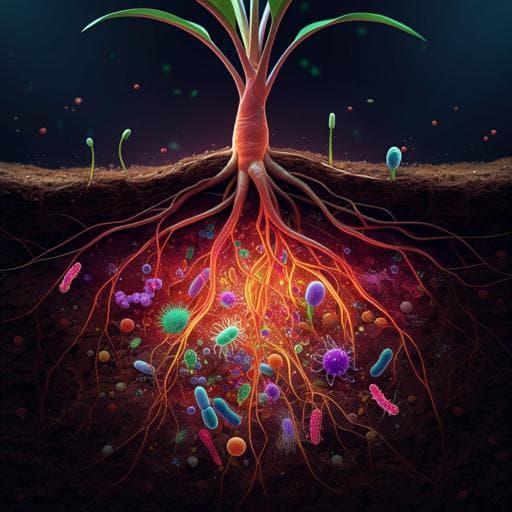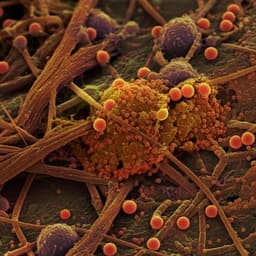
Agriculture
Legume rhizodeposition promotes nitrogen fixation by soil microbiota under crop diversification
M. Qiao, R. Sun, et al.
This research by Mengjie Qiao and colleagues unveils how intercropping peanut with maize and oilseed rape enhances peanut’s rhizosphere microbiota, boosting nitrogen fixation and metabolite production. A fascinating approach that highlights the potential of tailored intercropping to enrich soil nitrogen availability!
~3 min • Beginner • English
Introduction
The study addresses how interspecific plant interactions in diversified cropping systems (intercropping and rotation) influence chemical signaling in the rhizosphere and subsequent assembly and function of the rhizosphere microbiome of legumes. While root-exuded secondary metabolites are known to shape host-specific microbiota and enable functions such as nitrogen fixation and phosphorus uptake, less is known about how coexisting crop species modulate these processes in the field. Diversified systems often show improved performance, especially when legumes are included, but the mechanistic links to rhizosphere chemistry and microbiome-mediated N2 fixation remain unresolved. The authors hypothesize that crop combinations (peanut with maize and oilseed rape) alter peanut rhizodeposition (notably phenylpropanoid-derived flavonoids and coumarins), thereby selecting for and activating free-living and symbiotic N2-fixing bacteria, resulting in enhanced rhizosphere N availability and legume performance. The study combines multi-omics, bacterial isolation, and inoculation assays to identify rhizosphere metabolites influenced by cropping systems and test whether/how they trigger microbial N fixation and nodulation.
Literature Review
Prior work has established that plant–microbe chemical signaling shapes symbioses and rhizosphere microbiome assembly, with root exudates acting as selective filters and microbial signals feeding back on plant responses. Field studies have emphasized defense-related chemical feedbacks among non-kin plants but less on how such cues alter rhizosphere microbiomes to affect plant fitness. Legume nodulation requires precise host–microbe signaling (e.g., Nod factors and plant SYMRK/CCaMK/NIN pathways), and intercropped non-legumes can influence legume nodulation and N fixation. Flavonoids and coumarins, products of the phenylpropanoid pathway, are known to modulate microbiomes and symbioses and can be induced by environmental factors and neighboring plants. However, direct mechanistic evidence linking crop diversification to metabolite-mediated recruitment and activation of free-living and symbiotic N fixers in field systems has been limited.
Methodology
Field site and design: Long-term experiment (established 2011) at Yingtan Red Soil Ecological Experimental Station (Jiangxi, China; Ferralic Cambisol; subtropical climate). Three systems: PP (peanut monoculture), P-R (peanut–oilseed rape rotation), PM-R (peanut–maize intercropping rotated with oilseed rape). Randomized blocks (3), each with three replicate plots (20 m × 5 m × 1.5 m), subdivided into three subplots; plots separated by concrete baffles.
Cropping practices: PM-R used 1 m peanut strips (2 rows, 0.5 m interrow, 0.2 m intrarow) and 1 m maize strips (2 rows, 0.5 m interrow, 0.25 m intrarow). PP and P-R peanut spacing matched PM-R peanut density. Oilseed rape (P-R and PM-R) planted at 0.5 m interrow, 0.2 m intrarow. Annual fertilization: urea 150 kg ha−1 y−1 (46% N), Ca superphosphate 75 kg ha−1 y−1 (12.5% P2O5), KCl 60 kg ha−1 y−1 (60% K2O); half-doses for oilseed rape season. Baseline soil (2012): OM 4.58 g kg−1, TN 0.45 g kg−1, TP 0.35 g kg−1, TK 11.84 g kg−1, AP 1.68 mg kg−1, AK 54.17 mg kg−1, NH4-N 5.24 mg kg−1, NO3-N 2.59 mg kg−1, pH 4.84.
Sampling: On June 10, 2019 (peanut flowering), rhizosphere soils obtained by brushing adhering soil from six plants per subplot (composited; n=9 per treatment). Bulk soil cores (5–20 cm, 25 cm from roots) composited (n=9 per treatment). Subsamples stored at −80 °C (DNA), 4 °C (chemistry), and liquid N2 (metabolomics; n=7 due to freezer failure). Additional peanut roots collected June 15, 2020 for transcriptomics (PP and PM-R; seven plants per treatment).
Plant measurements: Height, biomass, nodule counts and biomass, cumulative root length (>1 mm). Nodule density (per 10 cm) and nodule-to-root mass ratio computed.
Soil chemistry: pH (2.5:1 water:soil), SOC (Walkley–Black), TN and inorganic N (Kjeldahl), TP (HF–HClO4 digestion), AP (carbonate/bicarbonate extraction, molybdenum blue), AK (NH4OAc extraction, flame photometry).
15N2 incubation for free-living N fixation: 10 g rhizosphere soil per vial; pre-incubated; headspace replaced with 78% 15N2 (99% atom) and 22% O2; incubated 7 days at 28 °C in dark with mid-incubation gas exchange; δ15N measured by EA-IRMS. Nine replicates per treatment, PP-air control included.
Bacterial community profiling: DNA extraction (FastDNA SPIN), V3–V4 16S rRNA amplicons (338F/806R), Illumina HiSeq 2500 PE; preprocessing (Cutadapt, DADA2), taxonomy (SILVA v138 via RDP Classifier), rarefaction to 16,000 reads/sample; diversity and dispersion analyses (Bray–Curtis, PCoA, ANOSIM, beta-dispersion).
Rhizosphere metabolomics: UHPLC–Q-Exactive Orbitrap MS in positive/negative modes (full MS-ddMS2); extraction with acetonitrile:isopropanol:water (1:1:1); processing with Compound Discoverer 3.0; annotation via mzCloud/HMDB/ChemSpider; targeted validation with standards (quercetin, hyperoside, scopoletin, syringaldehyde) by UHPLC-MS/MS.
Root transcriptomics and qRT-PCR: RNA extraction (plant/bacterial kits), library prep (TruSeq), Illumina HiSeq 2500 PE 150; trimming (Trimmomatic), mapping to Arachis hypogaea genome (HISAT2), expression (FPKM, Cufflinks; counts, HTSeq), DEGs (DESeq; q<0.05, |FC|>2), KEGG enrichment. qRT-PCR of peanut symbiosis genes (AhSYMRK, AhCCaMK, AhNIN) and bacterial nod genes (nodDI, nodC). Relative quantification by 2−ΔΔCt.
Bacterial isolation and assays: 109 heterotrophic isolates from PM-R rhizosphere (LB plates, 28 °C), 16S Sanger IDs; N2-fixing capacity screened on Ashby N-free agar. Twenty-seven isolates selected (including Pseudomonadales/Burkholderiales strains N4, OP14, N68, N69; rhizobia N43, N45, N47, N59; and 19 others). Microplate growth assays in 1/5 TSB with 5 μg mL−1 of each metabolite; V computed from OD600 growth (12–48 h) relative to control; n=6 per condition. Free-living N fixation measured in Ashby N-free liquid after 48 h by total nitrogen colorimetry.
Bradyrhizobium colonization and nodulation assays: Inoculation of peanut seedlings with rhizobia N43, N45, N47, N59 (YT-grown to OD600=0.5). N47 identified as effective nodulator; used to test metabolite effects on nodulation and signaling: seedlings in 1/5 MS medium inoculated with N47 plus 5 μg mL−1 metabolite; plant symbiosis gene expression at 24 h; nodules counted at 30 days. Bacterial nod gene induction: N47 cultures exposed to 0.5 μg mL−1 metabolites for 48 h; qRT-PCR of nodDI and nodC. GFP-marked N47 constructed for root colonization imaging (CLSM).
Medicago–Sinorhizobium model test: S. meliloti 1021 nod gene induction by metabolites (0.1 μg mL−1); Medicago truncatula A17 inoculated with S. meliloti with/without scopoletin (5 or 50 μg mL−1) to assess nodulation and defense gene responses.
Statistics: One-way ANOVA with Tukey’s HSD for multi-group comparisons; two-tailed t-tests for two-group comparisons; linear regressions for relationships among nodulation, N fixation, biomass, and rhizosphere N; checks for homoscedasticity and normality; multivariate analyses for metabolome/transcriptome and microbiome datasets in R.
Key Findings
- Crop performance and N uptake: In the three-crop system (PM-R), peanut height, biomass, and fruit weight increased by at least 19%, 66%, and 46% respectively vs PP and P-R (p<0.05), leading to 51% higher N uptake (p<0.05). Peanut biomass in P-R was lower than PP (p<0.05) without yield reduction (p>0.05).
- Nodulation: Compared to monoculture, PM-R had 3× higher nodule density (p<0.001) and 6× higher nodule-to-root mass ratio (p<0.001). Versus P-R, PM-R had 50% higher nodule density and 2× nodule-to-root mass ratio (p<0.05). Peanut biomass positively correlated with nodule-to-root mass ratio (p=0.026).
- Free-living N2 fixation and soil N: Rhizosphere soil 15N incorporation (after 7 days) was highest in PM-R, 16% and 4% higher than PP and P-R (p<0.05). Rhizosphere ammonium and nitrate were positively correlated with soil 15N fixation (p≤0.013). Rhizosphere NO3−-N and NH4+-N were 52% and 125% higher in PM-R vs PP; TN up 9% (all p<0.05). Bulk soil nutrients largely unchanged among systems except SOC, TP, AP increased in diversified systems.
- Rhizosphere metabolome: Among 2,891 MS features, 447 metabolites were annotated. PCA separated treatments (PC1=29.7%, PC2=13.5%; ANOSIM R=0.783, p=0.001). Forty-nine metabolites differed between PM-R and PP; 202 between PM-R and P-R (fold-change≥2, p<0.05). Four metabolites were specifically enriched in PM-R vs both PP and P-R (fold-change>2, p<0.001): quercetin, hyperoside (quercetin 3-O-galactoside), scopoletin, and syringaldehyde.
- Peanut root transcriptome: 2,911 DEGs in PM-R vs PP (1,589 up, 1,322 down; q<0.05, |FC|>2). Enriched KEGG pathways included ABC transporters (ko02010), phenylpropanoid biosynthesis (ko00940), cytochrome P450-related metabolism (ko00982, ko00980), consistent with biosynthesis/transport of flavonoids and coumarins.
- Bacterial community shifts: Crop diversification decreased beta-dispersion (greater compositional homogeneity; p=0.01) and altered taxonomic composition: increased Chloroflexi and Gammaproteobacteria, decreased Alphaproteobacteria (p<0.05). Multiple Gammaproteobacteria ASVs were enriched in PM-R; 49/68 PM-R-enriched ASVs correlated positively with at least one of the enriched metabolites (p<0.05).
- Isolates and metabolite responses: From 109 isolates (Firmicutes 54.1%, Actinobacteria 19.3%, Gammaproteobacteria 12.8%, Alpha 6.4%, Beta 5.5%), 27 were tested in microplates. The four focal strains (N4, OP14, N68, N69; Pseudomonadales/Burkholderiales) included three free-living N2 fixers (N4, N68, N69). At 5 μg mL−1, individual metabolites significantly affected growth rates of 48% of strains (p<0.05). None of the four focal strains were inhibited; they showed neutral/positive growth responses, and for N4/N68/N69, N2-fixation activity correlated positively with growth under metabolite addition.
- Symbiotic signaling and nodulation: Four rhizobial isolates (Rhizobium/Bradyrhizobium) were tested; only Bradyrhizobium N47 induced peanut nodules within 30 days. In pure culture, quercetin, hyperoside, and scopoletin increased N47 nodDI expression by 21–126% and nodC by 216–430% vs control; syringaldehyde had no effect. In peanut seedlings inoculated with N47, these metabolites upregulated host symbiosis genes AhSYMRK, AhCCaMK, AhNIN by 43–169% at 24 h, and increased nodule number by 21–90% at 30 days (p<0.05). Syringaldehyde did not enhance nodulation.
- Model confirmation: Similar nod gene stimulation by these metabolites was observed in Sinorhizobium meliloti 1021; scopoletin effects on Medicago truncatula nodulation were dose-dependent (enhanced at 5 μg mL−1; weaker at 50 μg mL−1).
Discussion
The findings demonstrate that intercropping peanut with maize (and rotation with oilseed rape) induces peanut root phenylpropanoid metabolism and selective rhizodeposition of flavonoids (quercetin, hyperoside) and a coumarin (scopoletin), which in turn shape the rhizosphere microbiome and enhance nitrogen acquisition. These metabolites act through two complementary mechanisms: (1) as substrates and selective cues that promote growth and activity of free-living N2-fixing taxa (notably Pseudomonadales/Burkholderiales), increasing rhizosphere 15N incorporation and inorganic N availability; and (2) as symbiotic signals that prime Bradyrhizobium nod gene expression and activate host symbiosis signaling (SYMRK–CCaMK–NIN), increasing nodulation. Community-level effects included reduced beta-dispersion and enrichment of metabolite-associated ASVs. Environmental factors associated with the intercropping context (e.g., shading, neighbor exudates) likely trigger phenylpropanoid pathway activation in peanut roots. Coumarins may contribute to both microbiome selection and symbiosis signaling but can be inhibitory at higher doses or primarily modulate gene expression without increasing nodule numbers in peanut. Overall, diversified cropping leverages plant–microbe chemical dialogues to build functional alliances that enhance legume fitness and soil N cycling, offering mechanistic insights for designing sustainable agroecosystems.
Conclusion
This study establishes a mechanistic link between crop diversification and enhanced biological nitrogen fixation in legume systems. Intercropping peanut with maize (and rotating with oilseed rape) upregulated phenylpropanoid biosynthesis and ABC transporter pathways in peanut roots, enriching rhizosphere flavonoids and coumarins (quercetin, hyperoside, scopoletin, syringaldehyde). These metabolites selected for and stimulated free-living N2-fixers and primed Bradyrhizobium–peanut symbiosis signaling, leading to higher nodulation, rhizosphere N availability, and improved peanut growth and N uptake. The results provide a framework for intelligent crop design that manipulates rhizodeposition to steer microbiome function and enhance ecosystem services. Future work should quantify metabolite fluxes and dose–response effects across environments and legume species, dissect individual versus combined metabolite actions, broaden the diversity of symbionts tested beyond a single effective Bradyrhizobium strain, and evaluate long-term N budgets and yield stability in diversified systems.
Limitations
- Metabolite origin: While transcriptomics indicates peanut biosynthesis, contributions from neighboring or prior crops cannot be fully excluded; diffusion constraints reduce but do not eliminate this possibility.
- Metabolomics replication: Two rhizosphere samples were lost (n=7 instead of 9), potentially reducing power.
- Symbiont scope: Only one Bradyrhizobium isolate (N47) effectively nodulated peanut in assays; generality across strains/species remains to be validated.
- Laboratory conditions: Microplate growth and nod gene induction assays and seedling nodulation tests may not fully capture field complexity or metabolite concentrations.
- Site specificity: Results stem from a single subtropical Ferralic Cambisol site; transferability to other soils/climates requires testing.
- 15N incubation: Short-term microcosm incubations indicate potential free-living N2 fixation but may not reflect season-long in situ rates.
- Potential confounders: Differences in canopy light/shade and microclimate in intercropping could contribute to plant responses alongside neighbor chemical effects.
Related Publications
Explore these studies to deepen your understanding of the subject.







